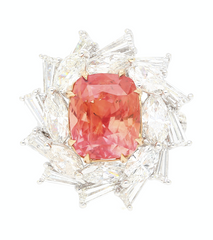Padparadscha: the Gem of Mystery

Intro:
The famed “Padparadscha” Sapphire is a very special color variety of sapphire consisting of a delicate mixture of pink and orange. These magnificent gems have taken the market by storm and have begun to command premiums at top auction houses around the world.
Name Origins:
Our story begins in the tropical island nation of Sri Lanka. South of India and overlooking the Arabian Sea, this region is rich with fine gemstones- specifically sapphires. While most of the finest gems from the island are Blue Sapphires, Padparadscha Sapphires were found exclusively in Sri Lanka until the last 10 years, where some were discovered in East Africa and Vietnam. However, the top quality stones that have appeared in the market have almost entirely been determined to be of Sri Lankan origin by the certifying lab.
Of course, in order to truly understand this gem, we need to go back to square one. The term “Padparadscha” is derived from “Padma Raga”, which translates from Sanskrit into “Lotus Flower”. The Lotus Flower, a beautiful pinkish-orange Lily Flower. It is the national flower of India, which historically shares borders and culture with Sri Lanka, as well as others. Padparadscha is thusly named due to the color of the flower. It has also been described more recently by Western Gemologists as a “sunrise” color. Regardless of the term, the ideal color range for Padparadscha Sapphires is objectively some mixture between pink and orange.

What is the Padparadscha Color:
Considering that the only thing that classifies a sapphire as “Padparadscha” rather than a standard colored sapphire is the mix of its colors, there needs to be clear standards as to what color “Lotus/Sunrise” truly is; that's when it starts to get tricky.
Many sapphires that have looked far more pink than orange (and vice-versa) have been bandied about as Padparadscha sapphires. In today's world, where the provenance and certificate of the gem have just as much bearing on its value, if not more, than the gems quality, it is very important that we remain diligent in our characterizations of stones. Gemstones have become akin to brand-name goods (i.e: “Burma No Heat”; “Royal/Cornflower Blue”, “Vivid Green Muzo Mine”, etc), so we must be careful to not debase Padparadscha sapphires by assigning them to every stone with pink or orange hues.

Richard W. Hughes, a world-renowned gemologist and founder of Lotus Gemology, published the following compendium about Rubies and Sapphires, his area of expertise over his decorated career. In the Padparadscha section, he takes some time trying to make sense of what color range is objectively a Padparadscha and how it should be defined/measured.

The author surveyed gem dealers to outline the specific color range for Padparadscha sapphires. While there was no clear consensus or conclusion, the “sunrise” or “lotus flower” descriptions are not far off. For example, the photo used to show Padparadscha sapphires amongst other color types shows a pastel, delicate pinkish-orange stone. And while his color survey showed some diversity of opinion, the contrast was not very sharp.

Historic Padparadscha Prices:
While color is the most important aspect of the stone, Padparadscha Sapphires are often cleaner than their other top-gem counterparts, such as rubies and emeralds. They are also most valuable when left untreated by heat treatment, a commonly employed clarity enhancement for sapphires and rubies. Prices for top Padparadscha Sapphires have hovered around $30,000 USD per carat, but in the last few years we have seen some go at auction for over $50,000 per carat. For example, in November 2017, Christie’s International Auction sold a 28 carat Orangey-Pink color (per SSEF) Padparadscha Sapphire for nearly $2.5 Million USD. This is in stark contrast to Christie’s June 2005 Jewelry Auction, where a nearly 21 carat superbly-colored Padparadscha sold for $375,000 USD. While the photos don’t do it justice, the stone from 2005 is perhaps the quintessential Padparadscha color and was a relative bargain. It is a stone growing in popularity, and consequently, in price.
Summary:
Padparadscha Sapphires have burst onto the scene in the world of fine gemstones. They are exceptionally rare, of legendary color, typically clean, and command high premiums at auction. While famed, they are still a bit of an unknown, especially in a rapidly growing and rapidly changing gemstone market. The Padparadscha Sapphire captures the essence of what draws us to gemstones in the first place- the mystery and allure of these miracles of nature.
A Rare Offer:
Assay is proud to offer a one of a kind 9.10 Carat No Heat Ceylon Padparadscha Sapphire, mounted with a mixed cut diamond halo and 18k white gold setting.

Sources:
- Hughes, Richard W., et al. Ruby & Sapphire: a Gemologists Guide. RWH Publishing, 2017.
- “Padparadscha Buying Guide.” Pala International.
- Hughes, Richard W. “Ruby, Pink Sapphire & Padparadscha • Walking the Line • Lotus Gemology.”
- “Padparadscha Sapphires : 10 Tips On Judging The Rare Gem.” The Natural Sapphire Company Blog, 29 Oct. 2015,
- https://www.christies.com/lotfinder/Lot/a-superb-coloured-sapphire-and-diamond-ring-6113381-details.aspx
- https://www.christies.com/lotfinder/Lot/an-extremely-rare-padparadscha-sapphire-and-diamond-4513705-details.aspx



